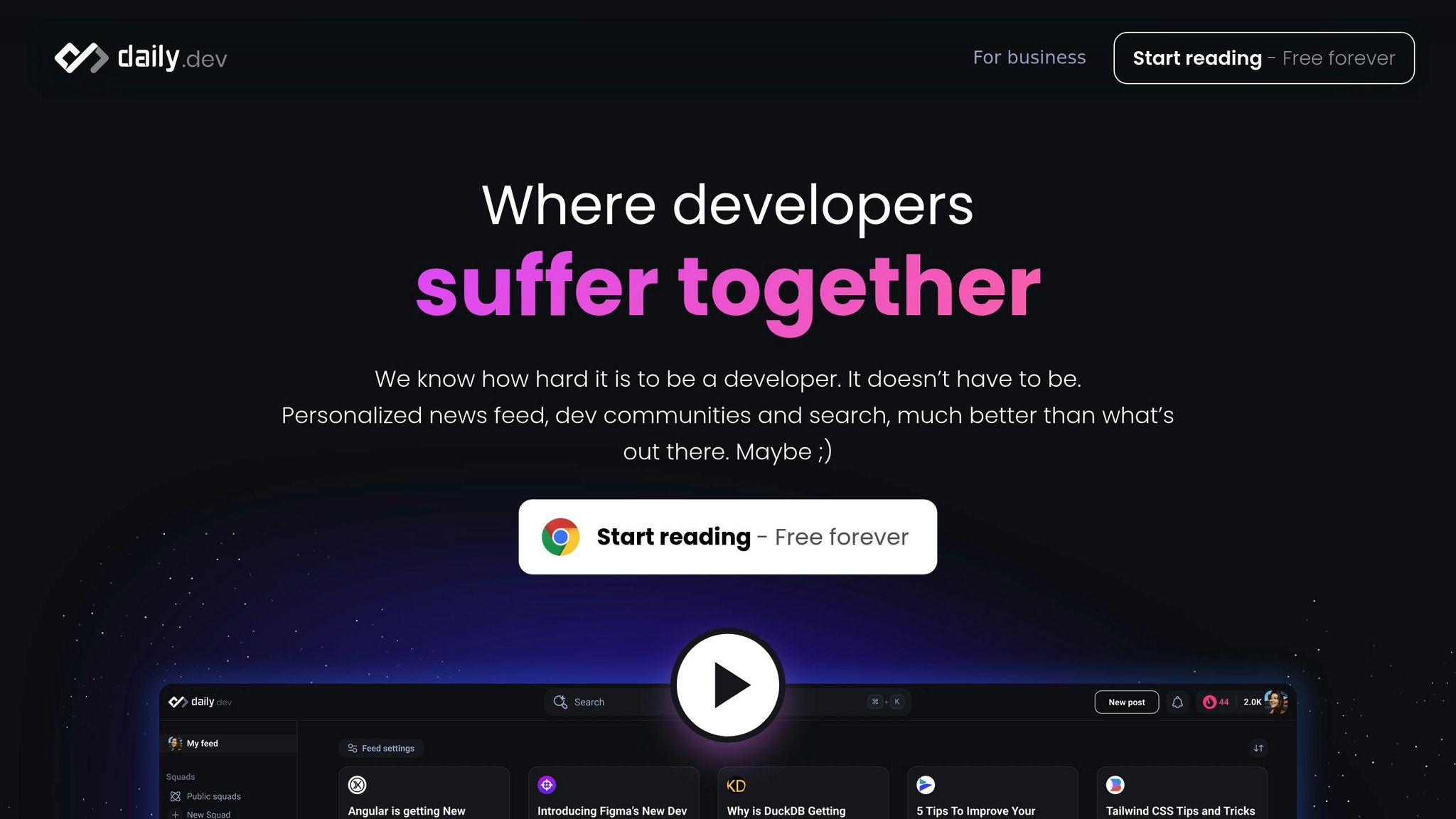


Explore the differences between contextual and native advertising, and learn which approach is best for effectively reaching developers.
If you want to reach developers effectively, you need to pick the right advertising approach. The two main options are contextual advertising and native advertising. Here's the difference:
- Contextual advertising places ads that match the content a user is currently viewing. For example, reading about Python? Expect ads for Python tools or courses.
- Native advertising blends into the platform's content, offering helpful, engaging material that feels like part of the experience. Think tutorials or case studies that subtly promote a product.
Key takeaway:
Contextual ads are great for quick results - like driving clicks or conversions. Native ads work better for building trust and long-term connections. Your choice depends on your goals, budget, and audience behavior.
Quick Comparison:
| Aspect | Contextual Advertising | Native Advertising |
|---|---|---|
| Targeting | Matches content and keywords | Aligns with platform style and audience |
| Appearance | Clearly labeled ads | Blends with organic content |
| Developer Response | Immediate action | Longer engagement |
| Best Use | Quick promotions | Building brand trust |
Use contextual ads for fast results and native ads for deeper engagement. Combining both can maximize your reach and impact.
What is Contextual Advertising? Your Guide to Getting Started Today!
What is Contextual Advertising?
Contextual advertising is an approach that delivers ads based on the content a user is currently viewing, rather than relying on personal data or browsing history. It works by analyzing the content of a webpage and serving ads that align with the topic being discussed.
For example, if a developer visits a page about Python programming, they might see ads for Python frameworks, coding tools, or programming courses, instead of unrelated products like home appliances or clothing.
This method resonates well with developers, who often prioritize privacy. Many developers use ad blockers to avoid intrusive ads, making contextual advertising a less invasive and more relevant way to connect with them.
How Contextual Advertising Works
Contextual advertising uses advanced algorithms to scan webpage content in real-time. These systems analyze the text, images, and overall themes of a page to determine its focus.
This process happens almost instantly. For instance, if a developer loads a page about containerization, the system might identify keywords like "Docker", "Kubernetes", or "microservices" and serve ads related to those topics, such as container orchestration tools or cloud services.
Modern systems go beyond basic keyword matching. Through semantic analysis, they grasp the deeper meaning of content. For example, an article about "debugging JavaScript applications" might trigger ads for debugging tools or JavaScript frameworks, even if those exact phrases aren’t in the advertiser’s keyword list.
These systems also factor in content sentiment and user intent. A troubleshooting guide might lead to ads for support services, while a tutorial on advanced features could prompt ads for premium tools or training courses.
Benefits of Contextual Advertising for Developer Marketing
Privacy compliance is a major strength of contextual advertising. Since it doesn’t rely on tracking cookies or personal data, it aligns with regulations like GDPR and CCPA. This is particularly important when marketing to privacy-conscious developers.
Relevance is another advantage. Ads that match the content developers are already engaging with tend to perform better. For example, a developer reading API documentation is more likely to click on ads for API testing tools or management platforms.
Reduced ad fatigue is achieved because these ads feel less intrusive. Instead of being tracked across the web, users see ads that naturally fit the context of what they’re reading or watching.
Brand safety improves as well. Advertisers can control where their ads appear, ensuring that their products are promoted alongside high-quality, relevant content rather than on sites that could harm their reputation.
Finally, cost efficiency often improves. By targeting users who are already interested in the topic, contextual ads tend to generate better click-through and conversion rates, leading to a stronger return on investment.
Common Contextual Advertising Formats
- Display banners: These ads feature graphics, logos, and calls-to-action and are placed on developer-focused websites. For example, you might see banners for cloud services or coding tools on technical blogs or documentation sites.
- Text ads: These appear as highlighted links or sponsored content within articles. They’re particularly effective on forums, Q&A sites, and technical documentation where visual ads might disrupt the experience.
- Sidebar placements: These ads provide consistent visibility without being intrusive. Developer-focused sites often use sidebars to promote tools, courses, or services alongside tutorials or guides.
- In-content recommendations: These native-style ads appear as "related" or "recommended" content blocks. They’re ideal for promoting tools, libraries, or educational resources tied to the article’s topic.
- Video ads: Pre-roll and mid-roll ads are shown during technical tutorials, conference talks, or coding demos. These ads can highlight development platforms, cloud services, or training materials relevant to the video’s subject.
- Newsletter sponsorships: Brands can reach developers by sponsoring technical newsletters. These ads appear alongside updates, tool announcements, or news that aligns with the advertiser’s goals and audience.
What is Native Advertising?
Native advertising is all about blending in. Unlike flashy banner ads that scream for attention, native ads are designed to match the look, feel, and tone of the content they appear alongside. They’re subtle, seamless, and purposefully crafted to feel like a natural part of the user’s experience.
For developer marketing, native advertising is especially effective because it respects the audience’s need for content that’s helpful and relevant. Instead of disrupting a developer’s flow with loud, irrelevant ads, native ads provide information that feels like an organic extension of what they’re already exploring.
Take, for example, a cloud platform promoting itself through a developer publication. Instead of a generic ad, it could appear as an article discussing best practices for scalability, complete with code snippets and technical insights. The goal? Educate first, promote second. This understated approach makes native ads a great way to engage developers without coming across as pushy.
How Native Advertising Works
Native advertising works by aligning with the platform’s design and tone. When developers scroll through their favorite tech sites or news feeds, native ads are designed to blend in with the content they’re consuming. The only giveaway is usually a small label like "Sponsored" or "Promoted."
The key to success lies in crafting content that resonates with the platform’s audience. For developers, this often means going deep: offering technical explanations, practical examples, and actionable advice. These ads mirror the quality of the organic content they sit alongside, making them feel less like ads and more like helpful resources.
Placement also matters. Native ads are strategically positioned to appear when developers are most engaged - like showing an ad for a database tool in an article about data architecture patterns. The format adapts to the platform too. On a technical blog, a native ad might take the form of an in-depth tutorial. On social media, it could appear as a discussion post or even a shared code snippet. This adaptability ensures the ad feels relevant and enhances the overall user experience.
Benefits of Native Advertising for Developer Marketing
Native advertising offers several clear advantages for reaching developers:
- Higher engagement rates: Developers are more likely to interact with ads that provide real value, like technical insights or problem-solving tips, rather than traditional sales pitches. This often translates to better click-through rates compared to standard display ads.
- Building trust: When developers learn about a tool through a tutorial or case study, it feels like a natural discovery. This educational approach helps build credibility and trust, making the brand more memorable.
- Avoiding ad blockers: Unlike traditional ads, native advertising doesn’t feel intrusive. Because it matches the style and tone of the platform while offering useful content, developers are less likely to dismiss it outright.
- Better brand recall: Developers are more likely to remember brands that helped them solve a problem or learn something new. Native ads, with their storytelling approach, leave a lasting impression.
- Higher-quality leads: Native ads tend to attract developers who are genuinely interested in the topic. For instance, someone engaging with an ad about API security is more likely to be a strong lead for security tools than someone who clicks on a random banner.
Common Native Advertising Formats
Native advertising can take on several forms, each tailored to fit the platform and audience:
- Sponsored content and tutorials: These appear in developer publications or news feeds and are designed to look like regular posts. They often include detailed guides, code examples, and real-world use cases, making them both informative and engaging.
- Newsletter placements: Native ads can be featured in technical newsletters, highlighting tools or resources that align with the publication’s focus. By matching the newsletter’s tone, these ads feel more like recommendations than promotions.
- Video sponsorships: These might include tutorials or conference talks that showcase tools in action. Developers appreciate seeing how a product works in a real-world context, making this format highly effective.
- Community forum recommendations: Native ads can appear in developer forums or Q&A sites as resource suggestions. This format mimics the natural way developers share advice and tools within their communities.
- Developer portal integrations: On documentation sites or API references, native ads might appear as related tools or recommended next steps. These placements add value by complementing the developer’s current task or learning goal.
sbb-itb-e54ba74
Contextual vs Native Advertising: Side-by-Side Comparison
Understanding the nuances between contextual and native advertising can sharpen your developer marketing efforts. While both methods are effective, they operate differently and shine in distinct scenarios.
Main Differences Between Contextual and Native Advertising
Contextual advertising connects with developers by matching ads to the content they're engaging with. For example, if a developer is reading about debugging tools, an ad for a related software solution might appear. Native advertising, on the other hand, integrates seamlessly into the platform's content, making it less about the specific topic and more about aligning with the platform's style and audience behavior.
Contextual ads are straightforward and typically labeled as ads, aiming for quick clicks and immediate results. Native ads blend into the content stream, focusing on delivering value and fostering trust through engaging, relevant material. This means the success of contextual ads is often measured by direct conversions, like clicks or purchases, while native ads are evaluated by metrics like engagement, brand recall, and their ability to build long-term relationships.
Comparison Table: Contextual vs Native Advertising
| Aspect | Contextual Advertising | Native Advertising |
|---|---|---|
| Primary Targeting Method | Matches content and keywords | Integrates with platform and audience behavior |
| Ad Appearance | Clearly identifiable and content-relevant | Blends naturally with organic content |
| Developer Response | Quick, action-driven interactions | Longer, more meaningful engagement |
| Trust Building | Through relevance and timing | Through valuable, helpful content |
| Best Use Cases | Product launches, quick conversions | Brand awareness, thought leadership, community building |
| Measurement Focus | Immediate results, click-through rates | Engagement, brand recall, and long-term impact |
| Content Requirements | Short, action-focused messaging | Detailed, educational, and story-driven content |
| Developer Perception | A helpful interruption when well-targeted | A natural part of their content experience |
| Budget Efficiency | Lower cost for content creation, high precision targeting | Higher up-front investment, potential for broader reach |
Both approaches serve different purposes in developer marketing. Contextual advertising is ideal for targeting developers with immediate needs, such as promoting a new tool or service while they're researching related topics. Native advertising, by contrast, is better suited for building a lasting connection with your audience, positioning your brand as a trusted resource within the developer community.
The choice between the two depends on your specific campaign objectives, budget, and where your target audience spends their time online. In many cases, combining both methods strategically can yield the best results - using contextual ads for immediate actions and native advertising to nurture long-term engagement and loyalty.
How to Choose the Right Advertising Approach
Selecting the best advertising strategy requires a clear understanding of your goals and the factors that influence how your message will connect with developers. The right approach hinges on aligning your objectives, audience behavior, and resources.
Matching Your Strategy to Developer Behavior
Start by defining your campaign's primary goal: Are you aiming to build brand recognition over time, or do you need to drive immediate actions like sign-ups or downloads? Each objective aligns with a specific advertising method. Contextual advertising works well for quick results, such as promoting a beta program or a new tool. On the other hand, native advertising is better suited for establishing thought leadership and fostering trust over the long term.
It’s also vital to go beyond generalizations about developers. Think about where they consume content and their preferred platforms, as these preferences can guide your choice of advertising approach.
Your budget is another critical factor. Contextual ads are often simpler and less costly to create, focusing on clear messaging and direct calls-to-action. Native ads, meanwhile, demand more effort and investment, as they typically involve creating high-quality, engaging content that educates or entertains while subtly promoting your brand.
Finally, assess your team’s strengths in content creation. If your team lacks the expertise to craft compelling native ads, contextual advertising might be a more practical starting point.
These considerations can help you make informed decisions, especially when leveraging tools like daily.dev Ads to optimize your campaigns.
How daily.dev Ads Supports Both Advertising Types

daily.dev Ads offers robust support for both contextual and native advertising, giving you the flexibility to tailor your campaigns to your needs. With its precision targeting, the platform allows you to reach developers based on their seniority, preferred programming languages, and the tools they use - key factors for both advertising styles.
For contextual advertising, daily.dev Ads ensures your ads appear alongside relevant content. For example, if a developer is reading about JavaScript frameworks, an ad for your Node.js tool can appear at the exact moment their interest is piqued.
Native advertising on the platform blends seamlessly into the developer’s experience. Formats like in-feed ads, post page ads, and personalized digest ads integrate naturally with the content developers are already engaging with, maintaining the flow of their reading experience.
With real-time performance tracking, you can monitor the effectiveness of both approaches. Contextual campaigns often deliver immediate results, while native ads allow you to track longer-term engagement metrics, helping you refine your strategy based on actual data.
With access to over 1 million developers globally, daily.dev Ads provides the reach and environment needed for both quick-conversion contextual ads and relationship-building native campaigns. The platform ensures your ads appear in a trusted space where developers already find value.
Decision Factors for Choosing Your Approach
Several factors can guide your decision:
- Campaign timeline: If you need fast results, contextual advertising is your go-to. Native advertising, however, is better suited for long-term strategies that build momentum over time.
- Keyword relevance: Contextual advertising thrives when developers are actively searching for terms related to your product or service. Strong search volume and clear intent make this approach particularly effective.
- Budget control: Contextual ads offer more predictable costs and precise budget management. Native advertising, on the other hand, requires flexibility as you optimize content performance over time.
Starting with a smaller budget can be a smart move. It allows you to test different approaches, gather data, and scale successful campaigns gradually. Incorporating A/B testing and analytics from the outset ensures continuous improvement and better-informed decisions.
Consistency is essential. Your advertising should align with your broader marketing efforts, reinforcing your brand message rather than creating conflicting impressions.
For the best results, consider combining both approaches. Use contextual ads to drive immediate conversions while leveraging native advertising to build trust and relationships over time. Together, these strategies can address both short-term and long-term goals effectively.
Conclusion: Contextual vs Native Advertising Summary
Contextual and native advertising each bring unique strengths to the table when it comes to reaching developers. Contextual advertising shines when developers are actively searching for solutions, making it an ideal choice for driving quick actions like tool downloads or beta sign-ups.
On the other hand, native advertising focuses on forming deeper connections by blending naturally into the developer's content journey. While it requires a bigger investment in content creation, it delivers higher engagement and fosters long-term trust - especially important for promoting more complex B2B developer tools.
To make the most of your marketing efforts, the key is to align your strategy with your goals. Use contextual ads to achieve immediate results, and rely on native ads to establish credibility and build lasting relationships.
With daily.dev Ads, you can leverage both approaches effectively. Gain access to over 1 million developers worldwide through options like in-feed ads for native integration or placements tailored to contextually relevant content. Real-time tracking ensures you can fine-tune your campaigns for better outcomes.
By combining both methods, you create a well-rounded strategy: contextual ads for quick wins and native ads for nurturing trust. This blend supports both short-term revenue goals and long-term brand growth, allowing you to connect with developers at every stage of their decision-making process.
The secret to success lies in aligning your advertising with developers' habits, your budget, and your timeline. Start with clear goals, experiment with different tactics, and adapt your campaigns to fit how developers work. This thoughtful approach will help you maximize your return on investment.
FAQs
How do I decide between contextual and native advertising for my marketing goals?
Deciding between contextual advertising and native advertising comes down to the specific goals of your campaign. If you’re aiming to show ads that directly relate to the content users are currently viewing, contextual advertising is a solid option. This type of advertising works by matching your message to the content on the page, making it more likely to grab attention.
Alternatively, if your focus is on creating ads that blend effortlessly into the platform’s design and improve the overall user experience, native advertising is the way to go. These ads are designed to look and feel like part of the platform, which can help build trust and awareness without interrupting the content flow.
To decide which approach fits best, think about whether your main priority is content alignment or a seamless user experience. Choosing the method that aligns with your audience’s habits and preferences can drive better engagement and improve your campaign’s ROI.
What challenges might arise when using native advertising for developer marketing?
Native advertising presents unique challenges in developer marketing due to the effort involved in crafting content that genuinely connects with this audience. Creating such tailored, high-quality material demands not only significant time but also a deep understanding of what developers value and how they behave.
On top of that, native ads tend to come with a heftier price tag compared to traditional display ads. The higher cost often stems from the need for strategic placements and the creation of engaging, well-integrated content. There's also the issue of transparency. Since native ads are designed to blend seamlessly with organic content, they can sometimes blur the lines between advertising and editorial. This lack of clarity may lead to trust issues, particularly if developers feel the intent behind the ad isn't clearly disclosed.
All these factors make native advertising a more intricate and expensive strategy, requiring thoughtful planning and execution to ensure it resonates with developers and achieves meaningful outcomes.
What’s the best way to measure the success of contextual and native advertising campaigns to ensure strong ROI?
To gauge the effectiveness of contextual and native advertising campaigns and ensure a solid return on investment (ROI), it's important to track metrics that align with your objectives. Start with the basics like conversion rate, click-through rate (CTR), and engagement metrics such as likes, shares, and comments. These give you a clear picture of how your audience is interacting with your content.
Dig a little deeper by monitoring audience behavior through indicators like scroll depth and time spent on your content. These metrics reveal how much of your message is being consumed and whether it's holding attention.
For a more detailed evaluation, look at the quality of engagement. This could include analyzing user attention spans or measuring how widely your campaign is being shared. Regularly reviewing these metrics helps you understand how well your ads connect with your audience, allowing you to fine-tune strategies and get the most out of your investment.






